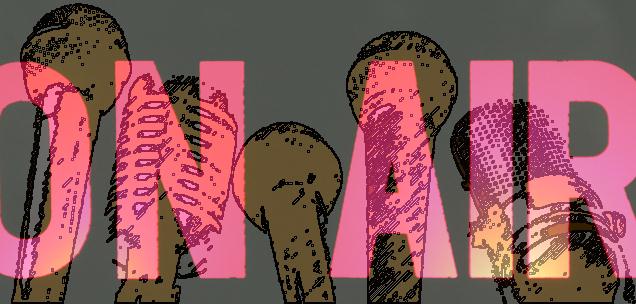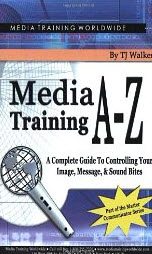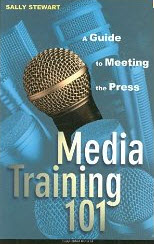Source of article Jury Insights.
 Communicating with the Media
Communicating with the Media
Style
In part II, (see Sept. 5 post) I discussed things the attorney should consider when preparing subject matter content for immediate interview.
In part III, I will focus on style rather than substance.
Interview Forum
Over the years, I have been interviewed over the phone, on radio, at the courthouse, and on TV. In most circumstances, I was able to take time to prepare beforehand.
Generally speaking, so to speak…
In all contexts, the following tips apply:
- It is almost never appropriate to be defensive or angry. However, there may be a circumstance in which a tone of righteous indignation might be appropriate.
- There is a common tendency to think that sober formality is called for in an interview. It is almost always better to speak in a conversational, idiomatic and vernacular style. It is important to avoid pretentious word fillers, such as “in the future,” “as it were,” or “if you will,” and beware of your individual stylistic verbal “tics.”
Caroline Kennedy’s political future effectively ended the day after she spoke extemporaneously to the media, when we found out, “you know,” she speaks well, “you know” except that, “you know” that verbal “tic” she has that tends to appear, “you know,” in every sentence.
- Although you prepare your content for the audience of the journalist, your style of speaking must address the individual journalist. You want to create the impression that you have a friendly rather than adversarial relationship with the journalist. Speaking as if to pass over the interviewer may sound arrogant to the ultimate audience.
- As you tell a witness who is preparing to testify, wait till the question has been asked before answering. Do not talk over the interviewer’s questions; but on the other hand, it is important to not allow the interviewer to trample over your answers.
- If the interviewer makes a factual error in a question, make sure you correct it before answering the question.
Telephone Interview
Telephone interviews have the advantage that the interviewer cannot see you, and the audience will not see you. However, it is the easiest circumstance to forget that there actually will be an audience for what you are saying. Because of the familiarity of speaking on the phone in a conversational style, the telephone presents a great temptation to get too loose and say too much.
In the Studio Radio Interviews
I think of the in the studio radio interview as the most comfortable format in which to be interviewed. You are constantly aware that there is an audience because you are speaking into a microphone, and there is a lot of equipment all around you. You do not have to remember to look into a camera and you are free to look around the room. The host of the radio interview is typically telegraphing to the audience what the next segment of the program is going to discuss. This makes it easy to think about how to steer a particular question to a thematic talking point answer that you have previously prepared. It is also likely that you will know the style of the host and the format of the program before you ever walk into the studio.
In the Studio TV Interviews
Studio TV interviews add a layer of complexity onto the radio interview. You need to think about what it is you are going to wear, and you need to think about the fact that there will be one or more cameras focusing on you.
TJ Walker, Sally Stewart and others advise:
- Do not wear stripes, herringbone, plaids, small designs or flashy jewelry.
- Avoid bright white shirts and blouses, and men should wear a collar that is flattering to your face and neck. As men get older the next get bigger. It is possible you may still be wearing a neck size that you may have outgrown years ago.
- Navy is a good color for TV, while red is a difficult color for the camera to capture accurately.
- Women should avoid things that dangle and reflect, and minimize makeup until you get advice from someone in the studio so that you do not unintentionally create a Tammy Faye Baker effect.
- Avoid slouching, gesturing too much, crossing and uncrossing your legs, licking or biting your lips, protruding your tongue or clenching your jaw.
- Avoid moving your head around to examine the room or the camera rolling around. Engage with and focus on the interviewer. Let the rest of the room fade into the background and let it go.
- Try to employ a slight forward “anchor person” lean.
TV interviews in an Isolation Room
I consider the TV interview taking place in an isolation room to be the most difficult format in which to be interviewed.
In this context, you are placed in a room that may have nothing else in it but a TV camera for you to face, while the interviewer is in a completely different location. There may not even be a monitor that provides you with an image of the interviewer, program commercials etc.
You will have a “bug” in your ear to hear what is going on, and will be cued to know when you are “on air.”
Your challenge will be to look into the camera and speak with a slight smile while talking. For most people, this is a skill that requires practice. When you are watching split screen interviews on TV, you are often watching an interviewee in an isolation room.
The Courthouse Interview
We have all seen media interviews of attorneys in the courtroom or on the courthouse steps. The greatest challenge to these interviews is their sometimes “surprise” nature.
You should always have your talking point content in your mind from the first day of trial. If you are ambushed, you should have something to say other than “no comment.”
The Courthouse Interview context may be one of the exceptions to the “give a short answer” rule. This may be the time to not answer the question that is asked, but give a filibuster, run out the clock narrative of your talking points, close the interview, and walk away.
In the Senate hearings examining the “where were Iraq’s WMDs and how the heck did we get into that war?” you may recall Condoleezza Rice demonstrating this technique to great effect. She knew that each Senator had a fixed amount of time, so she intentionally gave an answer that used up all the Senator’s allotted time and left no opportunity for follow up.
How to practice for TV interviews…
Just as you prepare witnesses for depositions, it is important to prepare yourself for TV interviews. Conceptual discussion of your options to reach talking point landmarks and avoid dangerous land mines is the first step. It is a necessary step, but not sufficient. Role play practice is essential. Practice role play using the same conditions you will encounter in the interview using an office-mate interviewer avatar. This is especially important for the isolation room TV interview.
Get out a camcorder or an Ipad to capture video, do a practice run and then examine what you look and sound like when answering questions. You will probably find that this results in a rapid learning curve.
If you know the style of the interviewer, have your interviewer avatar role-play that style. Role playing the interviewer requires some study and skill. Playing an authentic Charlie Rose is easy, but it’s a greater challenge to enact a dumb-gotcha Colombo, a ‘have you stopped beating your wife’ Sean Hannity, or an irreverent court jester Stephen Colbert.
Study the techniques that politicians use (Bill Clinton immediately comes to mind) to control the interview dialog with a friendly demeanor, and then seamlessly deflect difficult questions into transitions for talking points. These are the same techniques that many skilled expert witnesses use during cross examination. For example, the “part and part” technique refers to a response in which you minimize the germ of truth in an attacking question and then transition to the larger part of the truth that contradicts the germ of truth.
In a future post, I will identify and describe several of these techniques and to help you train “lay expert” witnesses, such as engineers and accountants, to give better testimony under cross examination.
Media Training References
As previously noted in Part I and II, I have found two short paperbacks to be very helpful: Media Training 101 by TJ Walker, and Media Training A-Z by Sally Stewart.


